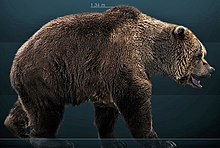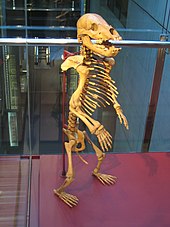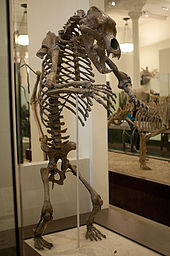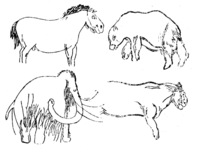Cave bear
| Cave bear Temporal range: Middle to Late Pleistocene,
| |
|---|---|

| |
| Mounted cave bear skeleton | |
| Scientific classification | |
| Kingdom: | |
| Phylum: | |
| Class: | |
| Order: | |
| Family: | |
| Genus: | |
| Species: | U. spelaeus
|
| Binomial name | |
| Ursus spelaeus Rosenmüller, 1794
| |

The cave bear (Ursus spelaeus) was a species of bear that lived in Europe during the Pleistocene and became extinct about 24,000 years ago during the Last Glacial Maximum.
Both the name "cave" and the scientific name spelaeus are because fossils of this species were mostly found in caves, showing that cave bears may have spent more time in caves than the brown bear, which uses caves only for hibernation. Consequently, in the course of time, whole layers of bones, almost entire skeletons, were found in many caves.
Taxonomy
Cave bear skeletons were first described in 1774 by Johann Friederich Esper in his book Newly Discovered Zoolites of Unknown Four Footed Animals. While scientists at the time considered that the skeletons could belong to apes, canids, felids, or even dragons or unicorns, Esper postulated that they actually belonged to polar bears. Twenty years later, Johann Christian Rosenmüller, an anatomist at the Leipzig University, gave the species its binomial name. The bones were so numerous, most researchers held little respect for them. During World War I, a large number of cave bear bones were used as a source of phosphates, leaving behind little more than skulls and leg bones.[1][2]
Many caves in Central Europe have skeletons of cave bears inside, for example the Heinrichshöhle in Hemer, the Dechenhöhle in Iserlohn, Germany. Complete skeleton, 5 complete skulls and 18 others was found inside Jaskinia Niedźwiedzia (en.Bear cave) in 1966 located in Poland.[3] In Romania, in a cave called Bears' Cave, 140 cave bear skeletons were discovered in 1983.[4]
Evolution
Both the cave bear and the brown bear are thought to be descended from the Plio-Pleistocene Etruscan bear (Ursus etruscus)[5][6][7] that lived about 5.3 Mya to 10,000 years ago. The last common ancestor of cave bears and brown bears lived between 1.2 and 1.4 Mya.[8] The immediate precursor of the cave bear was probably Ursus deningeri (Deninger's bear), a species restricted to Pleistocene Europe about 1.8 Mya to 100,000 years ago.[9][10] The transition between Deninger's bear and the cave bear is given as the last Interglacial, although the boundary between these forms is arbitrary, and intermediate or transitional taxa have been proposed, e.g. Ursus spelaeus deningeroides,[11] while other authorities consider both taxa to be chronological variants of the same species.[12]
Cave bears found in different regions vary in age, thus facilitating investigations into evolutionary trends. The three anterior premolars were gradually reduced, then disappeared, possibly in response to a largely vegetarian diet. In a fourth of the skulls found in the Conturines, the third premolar is still present, while more derived specimens elsewhere lack it. The last remaining premolar became conjugated with the true molars, enlarging the crown and granting it more cusps and cutting borders. This phenomenon, known as molarization, improved the mastication capacities of the molars, facilitating the processing of tough vegetation. This allowed the cave bear to gain more energy for hibernation, while eating less than its ancestors.[13]
Description

The cave bear had a very broad, domed skull with a steep forehead. Its stout body had long thighs, massive shins and in-turning feet, making it similar in skeletal structure to the brown bear.[14] Cave bears were comparable in size to the largest modern-day bears. The average weight for males was 400 to 500 kilograms (880 to 1,100 lb), while females weighed 225 to 250 kg (495 to 550 lb)*.[15] Of cave bear skeletons in museums, 90% are male due to a misconception that the female skeletons were merely "dwarfs". Cave bears grew larger during glaciations and smaller during interglacials, probably to adjust heat loss rate.[16]
Cave bears of the last Ice Age lacked the usual two or three premolars present in other bears; to compensate, the last molar is very elongated, with supplementary cusps.[17] The humerus of the cave bear was similar in size to that of the polar bear, as were the femora of females. The femora of male cave bears, however, bore more similarities in size to those of kodiak bears.[15]
Behaviour
Dietary habits
Cave bear teeth show greater wear than most modern bear species, suggesting a diet of tough materials. However, tubers and other gritty food, which cause distinctive tooth wear in modern brown bears, do not appear to have constituted a major part of cave bears' diets on the basis of dental microwear analysis.[18]

The morphological features of the cave bear chewing apparatus, including loss of premolars, have long been suggested to indicate their diets displayed a higher degree of herbivory than the Eurasian brown bear.[5] Indeed, a solely vegetarian diet has been inferred on the basis of tooth morphology.[6] Results obtained on the stable isotopes of cave bear bones also point to a largely vegetarian diet in having low levels of nitrogen-15 and carbon-13,[19][20] which are accumulated at a faster rate by carnivores as opposed to herbivores.
However, some evidence points toward the occasional inclusion of animal protein in cave bear diets. For example, toothmarks on cave bear remains in areas where cave bears are the only recorded potential carnivores suggests occasional cannibalistic scavenging,[21][22] possibly on individuals that died during hibernation, and dental microwear analysis indicates the cave bear may have fed on a greater quantity of bone than its contemporary, the smaller Eurasian brown bear.[23] Additionally, cave bear remains from Peștera cu Oase in the southwestern tip of the Romanian part of the Carpathian Mountains had elevated levels of nitrogen-15 in their bones, indicative of omnivorous diets,[20][24] although the values are within the range of those found for the strictly herbivorous mammoth.[25]
Although the current prevailing opinion concludes that cave bears were largely herbivorous, and more so than any modern species of the genus Ursus,[26] increasing evidence points to omnivorous diets, based both on regional variability of isotopic composition of bone remains indicative of dietary plasticity,[20][24] and on a recent re-evaluation of craniodental morphology that places the cave bear squarely among omnivorous modern bear species with respect to its skull and tooth shapes.[27]
Mortality

Death during hibernation was a common end for cave bears, mainly befalling specimens that failed ecologically during the summer season through inexperience, sickness or old age.[28] Some cave bear bones show signs of numerous different ailments, including spinal fusion, bone tumours, cavities, tooth resorption, necrosis (particularly in younger specimens), osteomyelitis, periostitis, rickets and kidney stones.[14] Male cave bear skeletons have been found with broken bacula, probably due to fighting during the breeding season.[28] Cave bear longevity is unknown, though it has been estimated that they seldom exceeded twenty years of age.[1] Paleontologists doubt adult cave bears had any natural predators, save for pack-hunting wolves and cave hyenas, which would probably have attacked sick or infirm specimens.[1] Cave hyenas are thought to be responsible for the disarticulation and destruction of some cave bear skeletons. Such large carcasses were an optimal food resource for the hyenas, especially at the end of the winter, when food was scarce.[29] The presence of fully articulated adult cave lion skeletons, deep in cave bear dens, indicates the lions may have occasionally entered dens to prey on hibernating cave bears, with some dying in the attempt.[30]
Recovery of fossil DNA
In May 2005, scientists in California recovered and sequenced the nuclear DNA of a cave bear that lived between 42,000 and 44,000 years ago. The procedure used genomic DNA extracted from one of the animal's teeth. Sequencing the DNA directly (rather than first replicating it with the polymerase chain reaction), the scientists recovered 21 cave bear genes from remains that did not yield significant amounts of DNA with traditional techniques.[31] This study confirmed and built on results from a previous study using mitochondrial DNA extracted from cave bear remains ranging from 20,000 to 130,000 years old.[8] Both show that the cave bear was closer related to the brown bear and polar bear than the American black bear, but had split from the brown bear lineage before the distinct eastern and western brown bear lineages diversified and before the split of brown bears and polar bears. The divergence date estimate of cave bears and brown bears is about 1.2–1.4 Mya.[8]
Range and habitat
The cave bear's range stretched across Europe; from Spain and Great Britain in the west, Italy, parts of Germany, Poland, the Balkans, Romania and parts of Russia, including the Caucasus; and northern Iran. No traces of cave bears have been found in Scotland, Scandinavia or the Baltic countries, which were all covered in extensive glaciers at the time. The largest numbers of cave bear remains have been found in Austria, Switzerland, northern Italy, northern Spain, southern France, and Romania, roughly corresponding with the Pyrenees, Alps, and Carpathians. The huge number of bones found in southern, central and eastern Europe has led some scientists to think Europe may have once had literally herds of cave bears. Some, however, point out though some caves have thousands of bones, they were accumulated over a period of 100,000 years or more, thus requiring only two deaths in a cave per year to account for the large numbers.[1]
The cave bear inhabited low mountainous areas, especially in regions rich in limestone caves. They seem to have avoided open plains, preferring forested or forest-edged terrains.[1]
Extinction


Recent reassessment of fossils indicate that the cave bear probably died out 24,000 years ago. A complex set of factors, rather than a single factor, are suggested to have led to the extinction.[32]
Compared with other megafaunal species that also became extinct during the last glacial maximum, the cave bear was believed to have had a more specialized diet of high-quality plants and a relatively restricted geographical range. This was suggested as an explanation as to why it died out so much earlier than the rest.[26] Some experts have disputed this claim, as the cave bear had survived multiple climate changes prior to extinction. Additionally, mitochondrial DNA research indicated that the genetic decline of the cave bear began long before it went extinct, demonstrating habitat loss due to climate change was not responsible.[32] Finally, high δ15N levels were found in cave bear bones from Romania, indicating wider dietary possibilities than previously believed.[20]
Overhunting by humans has been largely dismissed because human populations at the time were too small to pose a serious threat to the cave bear's survival, though the two species may have competed for living space in caves.[1][32] Unlike brown bears, cave bears are seldom represented in cave paintings, leading some experts to believe the cave bear may have been avoided by human hunters[33] or their habitat preferences may not have overlapped. The late paleontologist Bjorn Kurten hypothesized cave bear populations were fragmented and under stress even before the advent of the glaciers.[1] Populations living south of the Alps possibly survived significantly longer.[26]
Some evidence indicates that the cave bear used caves only for hibernation and was not inclined to use other locations, such as thickets, for this purpose, in contrast to the more versatile brown bear. This specialized hibernation behavior would have caused a high winter mortality rate for cave bears that failed to find available caves. Therefore, as human populations slowly increased, the cave bear faced a shrinking pool of suitable caves, and slowly faded away to extinction, as both Neanderthals and anatomically modern humans sought out caves as living quarters, depriving the cave bear of vital habitat. This hypothesis is being researched at this time. According to the research study, published in the journal Molecular Biology and Evolution, radiocarbon dating of the fossil remains shows that the cave bear ceased to be abundant in Central Europe around 35,000 years ago. "This can be attributed to increasing human expansion and the resulting competition between humans and bears for land and shelter," explains the scientist, who links this with the scarce fossil representation of the bear's prey in the abundant fossil record of this species.[34]
Relationship with humans
Between the years 1917 and 1923, the Drachenloch cave in Switzerland was excavated by Emil Bächler. The excavation uncovered more than 30,000 cave bear skeletons. It also uncovered a stone chest or cist consisting of a low wall built from limestone slabs near a cave wall with a number of bear skulls inside it. Also, a cave bear skull was found with a femur bone from another bear stuck inside it. Scholarship speculated that this was proof of prehistoric human religious rites involving the cave bear, or that the Drachenloch cave bear were hunted as part of a hunting ritual or that the skulls were kept as trophies.[35] In Archaeology, Religion, Ritual (2004), archaeologist Timothy Insoll strongly questions whether the Drachenloch finds in the stone cist were the result of human interaction. Insoll states that the evidence for religious practices involving cave bears in this time period is "far from convincing". He also states that comparisons with the religious practices involving bears that are known from historic times are invalid.[36]
A similar phenomenon was encountered in Regourdou, southern France. A rectangular pit contained the remains of at least twenty bears, covered by a massive stone slab. The remains of a Neanderthal lay nearby in another stone pit, with various objects, including a bear humerus, a scraper, a core, and some flakes, which were interpreted as grave offerings.
The unusual finding in a deep chamber of Basua Cave in Savona, Italy, is thought to be related to cave bear worship, as there is a vaguely zoomorphic stalagmite surrounded by clay pellets. It was apparently used by Neanderthals for a ceremony; bear bones scattered on the floor further suggests this was likely to have had some sort of ritual purpose.[37]
-
Cave bear and other Ice Age mammals, Grotte de la Mairie
-
Cave bear (upper right) along with other animals depicted in rock art from the Les Combarelles cave
See also
References
- ^ a b c d e f g Bieder, Robert (2005). Bear. London: Reaktion Books. p. 192. ISBN 1-86189-204-7. Cite error: The named reference "bieder" was defined multiple times with different content (see the help page).
- ^ Brunner, Bernd (2007). Bears : A Brief History. New Haven: Yale University Press. pp. 37–41. ISBN 9780300122992. Retrieved 15 December 2014.
- ^ Praca Zbiorowa, "Jaskinia Niedźwiedzia w Kletnie. Badanie i udostępnianie", Polska Akademia Nauk, Ossolineum, Wrocław 1989, ISBN 8304030373. Template:Pl icon with Template:En icon summary.
- ^ Cave Bears. Jan Kowalski. psu.edu
- ^ a b Kurtén, B. 1976: The Cave Bear Story. Life and Death of a Vanished Animal. Columbia University Press, New York.
- ^ a b Rabeder, G., Nagel, D. & Pacher, M. 2000: Der Höhlenbär. Species 4. Thorbecke Verlag, Stuttgart.
- ^ Argant, A. & Crégut-Bonnoure, E. 1996: Famille des Ursidae. In: Guérin, C. & Patou-Mathis, M. (eds.): Les grands mammiferes Plio-Pleistocenes d’Europe, 167–177. Masson, Paris.
- ^ a b c Loreille, O.; et al. (2001). "Ancient DNA analysis reveals divergence of the cave bear, Ursus spelaeus, and brown bear, Ursus arctos, lineages". Current Biology. 11 (3): 200–203. doi:10.1016/S0960-9822(01)00046-X. PMID 11231157.
- ^ Stuart, A. J. 1996: Vertebrate faunas from the early Middle Pleistocene of East Anglia. In Turner, C. (ed.): The Early Middle Pleistocene in Europe, 9–24. A. A. Balkema, Rotterdam.
- ^ Königswald, v. W., Heinrich, W.-D. (1999). "Mittelpleistozäne Säugetierfaunen aus Mitteleuropa – der Versuch einer biostratigraphischen Zuordnung". Kaupia. 9: 53–112.
{{cite journal}}: CS1 maint: multiple names: authors list (link) - ^ Argant, A. (1991). "Carnivores quaternaires de Bourgogne". Documents des Laboratoires de Géologie de la Faculté des Sciences de Lyon. 115: 1–301.
- ^ Mazza, P. & Rustioni, M. (1994). "On the phylogeny of Eurasian bears". Palaeontographica Abteilung A. 230: 1–32.
{{cite journal}}: CS1 maint: multiple names: authors list (link) - ^ Gli orsi spelèi delle Conturines/ Ursus Spelaeus. Altabadia.it. Retrieved on 2011-09-26.
- ^ a b Brown, Gary (1996). Great Bear Almanac. p. 340. ISBN 1-55821-474-7.
- ^ a b Per Christiansen (1999). "What size were Arctodus simus and Ursus spelaeus (Carnivora: Ursidae)?" (PDF). Annales Zoologici Fennici. 36: 93–102.
- ^ Macdonald, David (1992). The Velvet Claw. New York: Parkwest. p. 256. ISBN 0-563-20844-9.
- ^ Gli orsi spelèi delle Conturines/ Ursus Spelaeus. Altabadia.it. Retrieved on 2011-09-26.
- ^ Pinto Llona, A. C., Andrews, P. & Etxeberrı´a, P. 2005: Taphonomy and Palaeoecology of Cave Bears from the Quaternary of Cantabrian Spain. Fondacio´n de Asturias/Du Pont Ibe´rica/The Natural History Museum, Grafinsa, Oviedo.
- ^ Bocherens, H.; et al. (2006). "Bears and humans in Chauvet Cave (Vallon-Pont-d'Arc, Ardeche, France): Insights from stable isotopes and radiocarbon dating of bone collagen". Journal of Human Evolution. 50 (3): 370–376. doi:10.1016/j.jhevol.2005.12.002. PMID 16442587.
- ^ a b c d Trinkaus, Erik & Richards, Michael P. (2008). "Reply to Grandal and Fernández: Hibernation can also cause high δ15N values in cave bears". Proceedings of the National Academy of Sciences of the United States of America. 105 (11): E15. doi:10.1073/pnas.0801137105.
{{cite journal}}: CS1 maint: multiple names: authors list (link) - ^ "Prehistoric Cave Bears Weren't So Cuddly After All". FOXNews. 2008-01-09. Retrieved 2008-01-11.
- ^ Pacher, M. (2000). "Taphonomische Untersuchungen der Höhlenbären-Fundstellen in der Schwabenreith-Höhle bei Lunz am See (Niederösterreich)". Beiträge zur Paläontologie. 25: 11–85.
- ^ Pinto Llono, A.C. (2006). "Comparative dental microwear analysis of cave bears Ursus spelaeus Rosenmüller, 1794 and brown bears Ursus arctos Linnaeus ,1758" (PDF). Scientific Annals, School of Geology Aristotle University of Thessaloniki (AUTH). Special. 98: 103–108.
- ^ a b Richards, M.P.; et al. (2008). "Isotopic evidence for omnivory among European cave bears: Late Pleistocene Ursus spelaeus from the Pestera cu Oase, Romania". PNAS. 105: 600–604. doi:10.1073/pnas.0711063105.
- ^ Bocherens, H. 2003: Isotopic biogeochemistry and the paleoecology of the mammoth steppe fauna. In Reumer, F., Braber, F., Mol, D. & de Vos, J. (eds.): Advances in Mammoth Research, 57–76. Deinsea 9.
- ^ a b c Pacher M. & Stuart A.J. (2009). "Extinction chronology and palaeobiology of the cave bear (Ursus spelaeus)". Boreas. 38 (2): 189–206. doi:10.1111/j.1502-3885.2008.00071.x.
- ^ Figueirido, B.; et al. (2009). "Ecomorphological correlates of craniodental variation in bears and paleobiological implications for extinct taxa: an approach based on geometric morphometrics". Journal of Zoology. 277 (1): 70–80. doi:10.1111/j.1469-7998.2008.00511.x.
- ^ a b Kurten, Bjorn (1968). Pleistocene Mammals of Europe. New Brunswick, N.J.: AldineTransaction. p. 325. ISBN 0-202-30953-3. Cite error: The named reference "Bjorn" was defined multiple times with different content (see the help page).
- ^ "Prey deposits and den sites of the Upper Pleistocene hyena Crocuta crocuta spelaea (Goldfuss, 1823)in horizontal and vertical caves of the Bohemian Karst". CAJUSG. DIEDRICH & KARELŽÁK. Retrieved 2008-01-20.
- ^ 15th International Cave Bear Symposium – Spišská Nová Ves, Slovakia. 17–20 September 2009. (PDF) . Retrieved on 2011-09-26.
- ^ Noonan, James P.; et al. (2005). "Genomic Sequencing of Pleistocene Cave Bears". Science. 309 (5734): 597–599. doi:10.1126/science.1113485. PMID 15933159.
- ^ a b c Stiller, Mathias; et al. (2010). "Withering Away—25,000 Years of Genetic Decline Preceded Cave Bear Extinction". Molecular Biology and Evolution. 27 (5): 975–978. doi:10.1093/molbev/msq083. PMID 20335279.
- ^ The Walking Larder: Patterns of Domestication, Pastoralism, and Predation by Juliet Clutton-Brock, published by Routledge, 1990, ISBN 0-04-445900-9
- ^ [1]
- ^ Caves of Switzerland: Drachenloch
- ^ Insoll, Timothy, Archaeology, Religion, Ritual (2004), Routledge (London), ISBN 0415253136
- ^ B.G. Campbell & J.D. Loy (1996). Humankind emerging (7th ed.). New York: HarperCollins. pp. 440–441. ISBN 0-673-52364-0.


